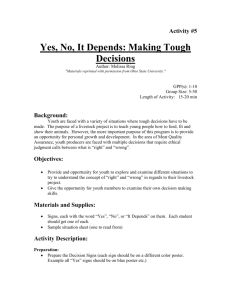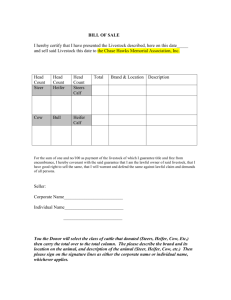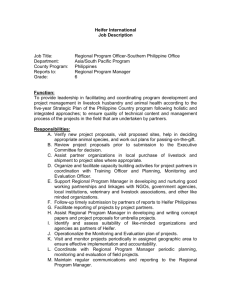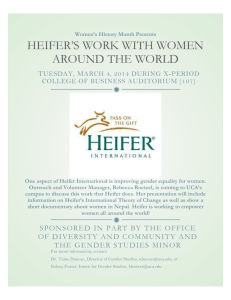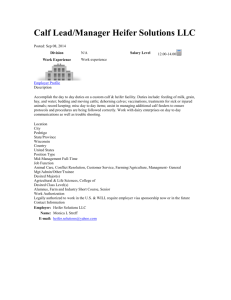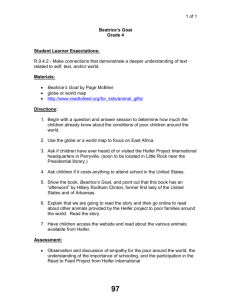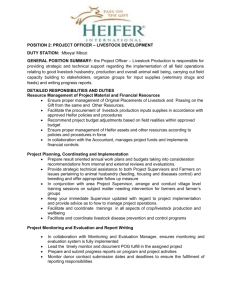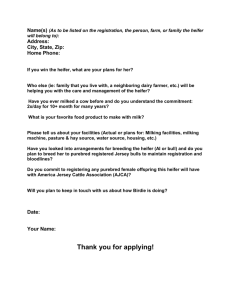Development of livestock based sustainable family farms: Heifer
advertisement
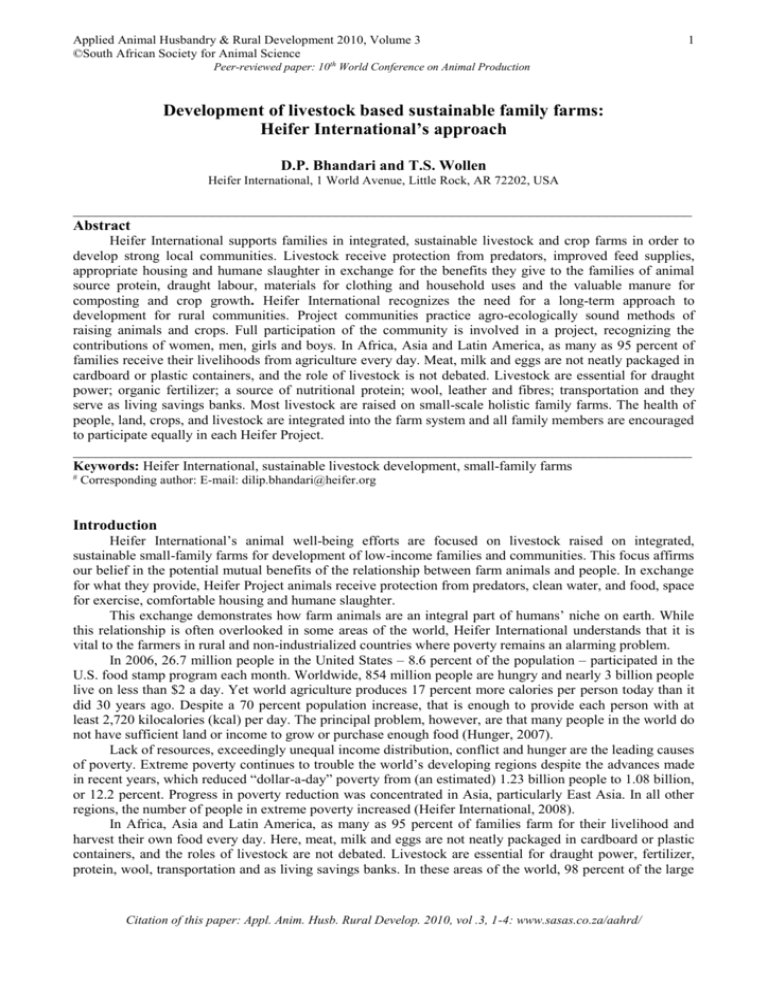
Applied Animal Husbandry & Rural Development 2010, Volume 3 ©South African Society for Animal Science 1 Peer-reviewed paper: 10th World Conference on Animal Production Development of livestock based sustainable family farms: Heifer International’s approach D.P. Bhandari and T.S. Wollen Heifer International, 1 World Avenue, Little Rock, AR 72202, USA ________________________________________________________________________________ Abstract Heifer International supports families in integrated, sustainable livestock and crop farms in order to develop strong local communities. Livestock receive protection from predators, improved feed supplies, appropriate housing and humane slaughter in exchange for the benefits they give to the families of animal source protein, draught labour, materials for clothing and household uses and the valuable manure for composting and crop growth. Heifer International recognizes the need for a long-term approach to development for rural communities. Project communities practice agro-ecologically sound methods of raising animals and crops. Full participation of the community is involved in a project, recognizing the contributions of women, men, girls and boys. In Africa, Asia and Latin America, as many as 95 percent of families receive their livelihoods from agriculture every day. Meat, milk and eggs are not neatly packaged in cardboard or plastic containers, and the role of livestock is not debated. Livestock are essential for draught power; organic fertilizer; a source of nutritional protein; wool, leather and fibres; transportation and they serve as living savings banks. Most livestock are raised on small-scale holistic family farms. The health of people, land, crops, and livestock are integrated into the farm system and all family members are encouraged to participate equally in each Heifer Project. ________________________________________________________________________________ Keywords: Heifer International, sustainable livestock development, small-family farms # Corresponding author: E-mail: dilip.bhandari@heifer.org Introduction Heifer International’s animal well-being efforts are focused on livestock raised on integrated, sustainable small-family farms for development of low-income families and communities. This focus affirms our belief in the potential mutual benefits of the relationship between farm animals and people. In exchange for what they provide, Heifer Project animals receive protection from predators, clean water, and food, space for exercise, comfortable housing and humane slaughter. This exchange demonstrates how farm animals are an integral part of humans’ niche on earth. While this relationship is often overlooked in some areas of the world, Heifer International understands that it is vital to the farmers in rural and non-industrialized countries where poverty remains an alarming problem. In 2006, 26.7 million people in the United States – 8.6 percent of the population – participated in the U.S. food stamp program each month. Worldwide, 854 million people are hungry and nearly 3 billion people live on less than $2 a day. Yet world agriculture produces 17 percent more calories per person today than it did 30 years ago. Despite a 70 percent population increase, that is enough to provide each person with at least 2,720 kilocalories (kcal) per day. The principal problem, however, are that many people in the world do not have sufficient land or income to grow or purchase enough food (Hunger, 2007). Lack of resources, exceedingly unequal income distribution, conflict and hunger are the leading causes of poverty. Extreme poverty continues to trouble the world’s developing regions despite the advances made in recent years, which reduced “dollar-a-day” poverty from (an estimated) 1.23 billion people to 1.08 billion, or 12.2 percent. Progress in poverty reduction was concentrated in Asia, particularly East Asia. In all other regions, the number of people in extreme poverty increased (Heifer International, 2008). In Africa, Asia and Latin America, as many as 95 percent of families farm for their livelihood and harvest their own food every day. Here, meat, milk and eggs are not neatly packaged in cardboard or plastic containers, and the roles of livestock are not debated. Livestock are essential for draught power, fertilizer, protein, wool, transportation and as living savings banks. In these areas of the world, 98 percent of the large Citation of this paper: Appl. Anim. Husb. Rural Develop. 2010, vol .3, 1-4: www.sasas.co.za/aahrd/ Applied Animal Husbandry & Rural Development 2010, Volume 3 ©South African Society for Animal Science 2 Peer-reviewed paper: 10th World Conference on Animal Production animals, such as dairy cows or water buffalo, are raised on small-scale family farms (Heifer International, 2008). In Nepal and the Philippines, more than 70 percent of farms use draught animals to prepare land for crops; and 40 percent of farmers worldwide depend on manure or manure compost to improve soil fertility and structure. Livestock also provide the opportunity to use food crops and by-products more efficiently. By feeding corn plants to cows, goats and sheep, 51 percent of the energy and 30 percent of the protein from that crop can be recuperated ( Heifer International, 2008). Heifer International’s Work in the Field Heifer International encourages livestock recipients to establish an integrated farming system where crops and livestock complement each other. One example of the benefits of this system is the farm of Nguyen Buu Chau in Vietnam, developed with support from Heifer International (Mathew, 2007). Nguyen’s farm exemplifies how the integrated farming system works. A barn has been constructed to help manage the cows he received from Heifer International. A few steps away are the kitchen with a vegetable garden and the farm’s crops. Beside a canal in the back, Nguyen keeps low, brick worm bins where chickens and ducks congregate. Cows are fed concentrates and leftovers from the kitchen, as well as elephant grass on the edge of the rice field. His children help to cut and feed the grasses as a part of their daily activities. The cow manure fertilizes the crop fields and kitchen garden. The manure also helps to recycle the crop nutrients by promoting healthy microbial action in the soil. Heifer International-Vietnam also helped Nguyen install a biogas unit below ground, which feeds methane from cow manure to the kitchen stove. The biogas unit is the primary method of cooking for the household, but provides more for the family than just a cooking source. The leftover sludge from the biogas is used as fertilizer to increase rice and corn production. Not all of the cow manure goes into the bio-gas unit. An above-ground compost heap is home to thousands of earthworms that turn organic waste into worm castings of concentrated nutrients, which become a natural plant fertilizer. Once separated from the castings, the worms make a high-protein feed for the chickens and ducks. The poultry in turn provide eggs, meat and insect control, and the manure from these birds is rich in nitrogen and phosphorus, further fertilizing the garden. Appropriate Livestock Management for Small Scale Farmers Because human management determines much of the well-being of farm animals, training is an essential part of Heifer International’s work. Heifer International ensures that training in animal husbandry is provided before animals are delivered, and that the training is consistent with animal well-being. Animal Breeding It is important that breed selection is appropriate to the region and system in which livestock will be raised. Heifer International believes genetic diversity and the use of indigenous breeds is as critical for livestock as it is for crops. Heifer International promotes the use of local breeds of animals that are adapted to the region. Improving the genetics of local breeds is one of the primary reasons that poor farmers request assistance from Heifer International. Heifer International recommends crossbreeding to improve the quality of local livestock, using artificial insemination (AI) rather than importing non-native breeds from abroad. When further improvement in livestock quality is necessary in order to meet market demands, appropriate male or female animals are imported. Farmers are trained in the care and management of these animals. Animals from outside the local area are shipped humanely and tested to ensure they are disease-and pathogen-free. These animals are quarantined for a proper period and acclimatized to their new conditions. The costs of transportation, compliance with international health requirements and adapting imported animals to local conditions, make the use of AI and breed improvement programmes for local animals a wiser choice than providing project participants with non-native animals. Animal Housing and Care In addition to shelter from harsh environments, housing should provide access to exercise, ventilation, and comfortable bedding. Sound manure and urine management is also important in humane housing for Citation of this paper: Appl. Anim. Husb. Rural Develop. 2010, vol .3, 1-4: www.sasas.co.za/aahrd/ Applied Animal Husbandry & Rural Development 2010, Volume 3 ©South African Society for Animal Science 3 Peer-reviewed paper: 10th World Conference on Animal Production confined animals. Heifer International animals are kept in a wide variety of housing, depending on traditions in the area. In many countries farmers construct a standard “zero-grazing unit” for cows or for goats. This popular methodology provides many opportunities to enhance health and well-being of animals by protecting them from adverse environmental conditions and predators, ensures provision of adequate food and water, reduces aggression in many species and enhances producers’ ability to observe and access animals when they require care and handling. Zero-grazing units also allow easy collection of manure for use in gardens, crop fields and biogas installations. Poultry, sheep and goats are often tended by children, while larger animals are cared for by the parents. When traditional methods of livestock care do not meet the minimum standards set by Heifer International’s Animal Well-Being Recommendations, training is provided and projects are monitored regularly. Animal Nutrition Good nutrition is essential for healthy animals. Most of the training Heifer International provides, improves farmers’ existing knowledge of the nutritional requirements of livestock. Farmers examine the basics of livestock nutritional needs, plant grasses and leguminous plants to supplement the natural pastures, and in many cases, learn about feed by-products available in their areas. Ruminants (cows, goats, and sheep) on small farms are seldom fed much grain, and hogs and chickens are usually fed residues or poorer quality feeds that are appropriate for livestock. Cattle supplements include bran, oilseed cake and other ingredients which are not common to human diets. Before any project is approved, Heifer must ensure that farmers can feed the livestock adequately without jeopardizing the food for the family. Feed sources must be readily and consistently available, and pastures or trees must be planted and producing before heifer animals are brought to the farms. Animal Health Care Heifer International has found that good preventive care (good nutrition, good husbandry, vaccinations, and anti-parasite strategies) often makes medicinal drug use unnecessary, except in cases of severe illness and disease outbreaks. Heifer International staff, local veterinarians and Community Animal Health Worker address animal health issues. Training local project participants has been successful in managing routine health problems in the field. Locally trained practitioners combine both traditional and modern drugs to cure illnesses. The main focus of Community Animal Health Worker is indigenous remedies, preventive care and links to local veterinary systems (Catley et al., 2002). The Community Animal Health Worker program has provided profound results in caring for animals in the communities, especially in Heifer International’s projects in Africa and Asia. Animal Handling, Use and Processing Good animal husbandry includes handling and management practices, such as castration and dehorning at the appropriate age and use of procedures that reduce or eliminate pain. Trained technicians perform these procedures. Livestock provide many valuable assets to project families. Cows, water buffalo, goats, sheep, camels, yaks and other animals provide nutritious milk. Likewise, many useful materials are made from wool, hair, fibres and hides. The sale of animal offspring and animal products also provides money. Many animals provide power for transportation and land tilling. Meat and eggs are provided by many species, and can be used by the family, sold or used at local festivals. Simply owning animals provides dignity and motivation within the community. The manure from livestock provides a relatively free and valuable commodity for integrated cultivated farming. Finally, Heifer emphasizes humane slaughter with the least amount of anxiety and use of the proper equipment. Conclusions Heifer International staff and the farmers who participate in Heifer International’s projects consider animal well-being to be of vital importance. The health of people, land, crops, and livestock are integrated into the farm system and all family members are encouraged to participate equally in the project. The holistic nature of program development and implementation is successful in bringing about changes in the lives of Citation of this paper: Appl. Anim. Husb. Rural Develop. 2010, vol .3, 1-4: www.sasas.co.za/aahrd/ Applied Animal Husbandry & Rural Development 2010, Volume 3 ©South African Society for Animal Science 4 Peer-reviewed paper: 10th World Conference on Animal Production people who receive livestock, and significantly contributes to ending hunger and poverty while caring for the earth. References Catley A., Blakeway, S. & Leyland, T.,2002. Community-based animal health care: A practical guide to improving primary veterinary services. ITDG Publishing, 103-105 Southampton Row, London WC1B 4HL, UK. Heifer International, 2008. The Well-Being of Heifer International Animals: A training document from Heifer International, 1 World Avenue, Little Rock, AR 72202, USA. Hunger, 2007. Healthy food, farm and families. Bread for the World & Bread for the World Institute. 50 F Street, NW, Suite 500 · Washington, D.C., 20001, USA. Mathew, J., 2007. Integrated farming in Vietnam. In: World Ark, July-Aug’07.Heifer International, 1 World Avenue, Little Rock, AR 72202, USA. pp. 7-16. Citation of this paper: Appl. Anim. Husb. Rural Develop. 2010, vol .3, 1-4: www.sasas.co.za/aahrd/
